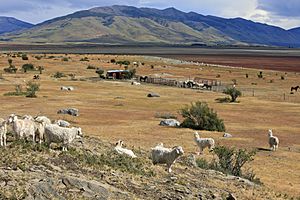Estancia facts for kids
An estancia is a very large piece of private land. It is mainly used for farming or raising animals like cattle or sheep. In the southern South American grasslands, called the pampas, estancias have traditionally been big farms for livestock. This means they raised animals such as cattle or sheep.
In Puerto Rico, an estancia was a farm that grew frutos menores. These were crops meant for local sale and eating, not for big exports. You could think of them like a small local farm in the United States. In Argentina, estancias are large country properties. They are quite similar to what people in the United States call a ranch.
Contents
History of Estancias
In the early days of Spanish rule in the Caribbean and Mexico, people who received land grants called encomiendas also got access to local workers. They needed Spanish supervisors on site. These supervisors were called estancieros. In Mexico, if one person owned many estancias, they might be called a hacienda.
The word estancia is used in different ways in Argentina, Paraguay, Uruguay, southern Chile, and southern Brazil. In other Spanish American countries, a similar large farm would be called a hacienda.
How Estancias Grew
For the first few centuries of Spanish rule, the Spanish brought cattle to their colonies. In places like northern Mexico and southern South America, these animals often roamed freely. Settlers would go on trips to catch and butcher them when needed.
By the 1800s, more permanent ranching started in the pampas. These new ranches had lasting buildings and marked animals to show who owned them. They were called estancias, which showed they were fixed and permanent places.
The Gaucho
The ranch worker on horseback in Argentina is called a gaucho. The gaucho is a very important part of Argentina's history and national identity. They are similar to the cowboys of North America.
Since the late 1900s, farming has become a bigger business. Because the soil in the pampas of Argentina and Uruguay is very good, many landowners have switched from raising animals to growing crops.
Estancias Today
A few estancias in Argentina and Uruguay, and also in Paraguay or Chile, have been turned into guest ranches. These are often places with old, interesting buildings. They are sometimes called paradores.
Many cities and villages, mostly in Latin America, grew from these estancias. They are often named after them. For example:
- Estância in Sergipe state, Brazil
- Estancia El Brete, Salta Province, Argentina
- Estancia, Iloilo in the province of Iloilo, Philippines.
California Mission Estancias
Many California missions in North America had their own separate farms and ranches. These were known as California mission estancias. They were different from the California ranchos, which were land grants given to individuals.
Estancias in Puerto Rico
During the time of Spanish rule in Puerto Rico (from 1508 to 1898), an estancia was a piece of land used for growing frutos menores. These were "minor crops" grown in smaller amounts. They were meant for local sale and use across the island, not for big exports.
Some of these frutos menores included rice, corn, beans, sweet potatoes (batatas), ñames, yautías, and pumpkins. Fruits grown included plantains, bananas, oranges, avocados, and grapefruits.
A farm that had machines to process its crops into things like juices, marmalades, or flour for selling in large amounts or for export was not called an estancia. Instead, it was called a hacienda. Most haciendas grew sugar, coffee, and tobacco, which were crops meant for export. While some estancias were larger than some haciendas, this was usually not the case.
See also
- Estancia para niños (in Spanish)
- Finca Los Alamos estancia in Argentina
- Station, a similar type of large farm in Australia


